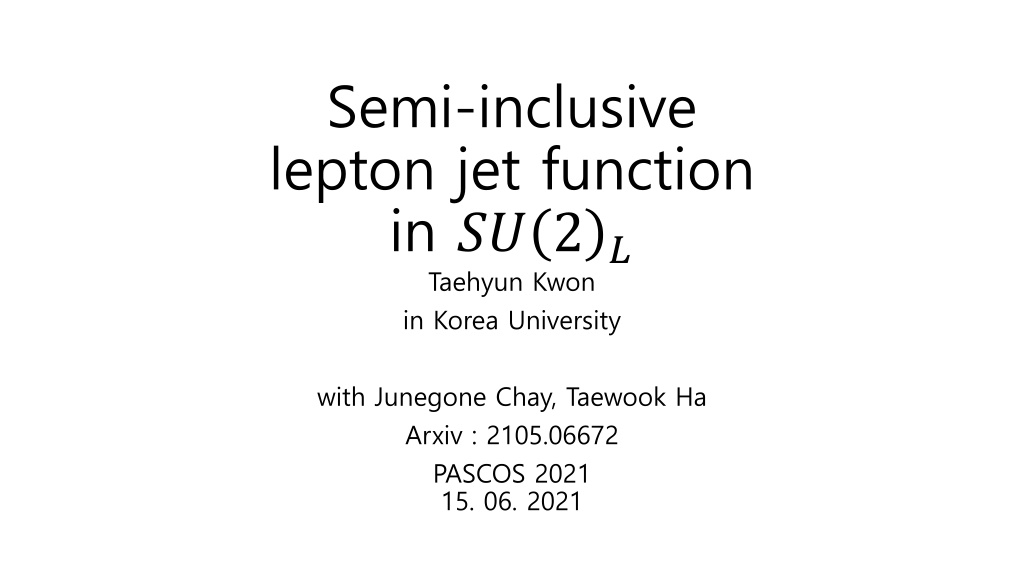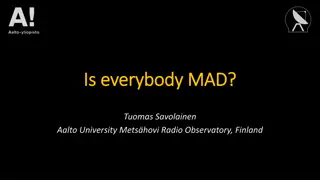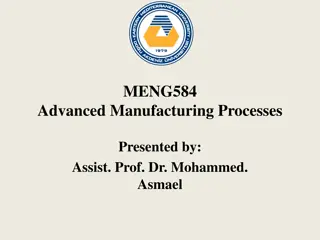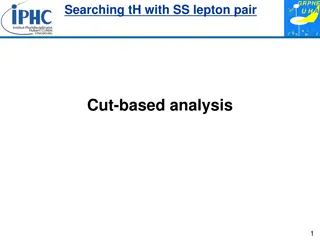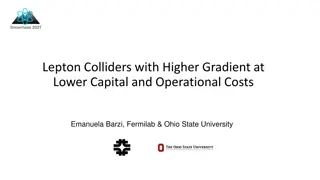Semi-inclusive lepton jet function
Consider a world without QCD, where particles can be observed as non-singlets in an electroweak gauge theory. Explore the differences between QCD jet functions and leptonic jet functions, focusing on non-singlet contributions and the factorization of 2-jettiness using SCET. Address issues like rapidity divergence and the need for new regularization techniques.
Download Presentation

Please find below an Image/Link to download the presentation.
The content on the website is provided AS IS for your information and personal use only. It may not be sold, licensed, or shared on other websites without obtaining consent from the author.If you encounter any issues during the download, it is possible that the publisher has removed the file from their server.
You are allowed to download the files provided on this website for personal or commercial use, subject to the condition that they are used lawfully. All files are the property of their respective owners.
The content on the website is provided AS IS for your information and personal use only. It may not be sold, licensed, or shared on other websites without obtaining consent from the author.
E N D
Presentation Transcript
Semi-inclusive lepton jet function in ?? 2? Taehyun Kwon in Korea University with Junegone Chay, Taewook Ha Arxiv : 2105.06672 PASCOS 2021 15. 06. 2021
Introduction Motivation Let s consider the world without QCD, where there is only electroweak gauge theory. Then, what happens? The particles in QCD are always observed as hadrons, that are the color singlet states. However, in the electroweak gauge theory, the particles can be observed as non-singlets. For example, we can observe an electron, not a quark alone. In the electroweak gauge theory, at high energy, a lot of leptons can be produced by the weak interaction. They make leptonic jets. How do we describe the leptonic jet? What are the differences between the QCD jet function and the leptonic jet function?
Introduction Problem Setup We consider for the 2-jettiness, ?++ ? ?+??? + ? ??? + ? Unlike QCD, the leptonic jet can be the non-singlet. We focus on the non-singlet contributions. For simplicity, we will consider only ?? 2?. In the high energy where the masses of all particles are regarded as small, we can use unbroken gauge theory.
2-Jettiness ? = ?1+ ?2+ ?3+ ?4 ?? is defined as ?3 where ?? s are jet directions. ?? corresponds to sharpness of the jet. ?3 ?2 ?1 ?2 ?? is large. ??is small. ?1 ?4 ?? ?? We consider this case with SCET. ?4
SCET Soft Collinear Effective Theory ??-Collinear Useful theory to factorize the cross section with 2 modes. - Collinear mode - Soft mode Soft ??-Collinear Hard ??-Collinear Modes n-collinear Power counting ??= ? ?,? ?,? ?(1,?2,?) ?? ?(?2,?2,?2) ??-Collinear Soft
SCET factorization for the 2-jettiness The cross section for the 2-jettiness is written as ?? ?? ?? ??????(? (?1+ ?2+ ?3+ ?4+ ??)) S ?? ???? ??1= ?1?1 ?2 ??2= ?2?2 H ?1 ??4 ??3 2= ?3?3 ?4 2= ?4?4 ?? ?3 ????(??), ?????? where ??are the large momenta in the light-cone coordinate, ?? and ?? beams and the jets, respectively. ?? 2are the offshellness of the
Rapidity divergence Rapidity divergence There is rapidity divergence in the region where ? ? (or ? ?) is infinite, while ? ? ? ? is fixed. UV ?-collinear divergence Dimensional regularization cannot handle the rapidity divergence. We need a new regularization. - Rapidity regulator. Ultrasoft ?-collinear Rapidity divergence (? is rapidity scale.)
Semi-inclusive lepton jet functions Singlet Non-singlet
At order ? Singlet Non-singlet Sudakov double logarithm ? dependence
The resummation of the large logarithm ???,?? ??? ??????,?? ???,?? ?2 ???,?? ?3 ???,?? ?4 ? ????? ?1 All the factorized parts have common scales ?? and ??, which can make the logarithms large in some of the parts. We have to resum the logarithm by evolving each part.
Renormalization Group Equation (RGE) Cusp. Singlet Non-Cusp. where Non-singlet
The solutions of RGE for singlet Singlet Note that
The solutions of RGE for non-singlet Non-singlet The evolution is path-independent by the following relation. Note that
Conclusion The leptonic jets including a lepton are described by semi-inclusive lepton jet functions. In contrast to the QCD jet function for the jettiness, the non-singlet semi- inclusive lepton jet function has the rapidity divergence that is handled by the rapidity regulator, not the dimensional regularization. Because of the rapidity divergence, the non-singlet semi-inclusive jet function is evolved with respect to the two scales, ? and ?, while the singlet is evolved with respect to only ?. What we have done. - Calculation of the other factorized parts. - Confirmation that cross-section is independent of ? and ?.
Conclusion The leptonic jets including a lepton are described by semi-inclusive lepton jet functions. In contrast to the QCD jet function for the jettiness, the non-singlet semi- inclusive lepton jet function has the rapidity divergence that is handled by the rapidity regulator, not the dimensional regularization. Because of the rapidity divergence, the non-singlet semi-inclusive jet function is evolved with respect to the two scales, ? and ?, while the singlet is evolved with respect to the one, ?. What to do next. - Extension to ?? 2? ?(1) gauge theory for studying real world. - Matching the unbroken theory to the broken theory. - Other analysis (??-mearsurement, sub-jet structure, etc..)
Introduction Motivation The particles in QCD are confined. Let s consider the imaginary world where any particle is not confined. We can think QCD with non-singlet free particles, but for simplicity, Let s consider the world without QCD. In the imaginary world without QCD, at high energy, a lot of leptons can be produced by the weak interactions. They make leptonic jets. The particles in the QCD jets must be the color singlets while the particles in the leptonic jets can be the non-singlets.
The common scales ????(??,??) ???,?? ??? ???,?? ?2 ???,?? ?3 ???,?? ?4 ? ????? ?1
